Interannual and Seasonal Variation of Optical and Microphysical Properties of Aerosol in the Baikal Region
Abstract
:1. Introduction
2. Materials and Methods
- (1)
- Determination with the help of sun sensor situations of “cloudless sun”;
- (2)
- First, rough aiming of the photometer, then precise tracking of the sun;
- (3)
- Measurement and signals accumulation of atmosphere spectral transparency;
- (4)
- When the sun is covered by clouds—transfer of the photometer to the “parking” position;
- (5)
- Self-diagnostics—control of the photometer temperature, supply voltages, etc.
3. Results and Discussion
3.1. Study Area
3.2. Study of Optical and Microphysical Characteristics Aerosol Properties in the Tory Station Atmosphere
3.3. The Results of Studies of the AOD Atmosphere at the Boyarsky Station
4. Conclusions
Author Contributions
Funding
Institutional Review Board Statement
Informed Consent Statement
Data Availability Statement
Conflicts of Interest
References
- Ivlev, L.S. The Chemical Composition and Structure of Atmospheric Aerosols; LSU: Leningrad, Russia, 1982; 368p. [Google Scholar]
- Fuks, N.A. Aerosol Mechanics; Publisher of the USSR Academy of Sciences: Moscow, Russian, 1955; 349p. [Google Scholar]
- IPCC. Climate Change 2013: The Physical Science Basis. Contribution of Working Group I to the Fifth Assessment Report of the Intergovernmental Panel on Climate Change; Stocker, T.F., Qin, D., Plattner, G.-K., Tignor, M., Allen, S.K., Boschung, J., Nauels, A., Xia, V., Bex, P.M., Eds.; Cambridge University Press: Cambridge, UK; New York, NY, USA, 2013; 1535p. [Google Scholar]
- Kumar, K.R.; Boiyo, R.; Khan, R.; Kang, N.; Yu, X.; Sivakumar, V.; Devi, N.L. Multi-year analysis of aerosol optical properties and implications to radiative forcing over urban Pretoria, South Africa. Theor. Appl. Climatol. 2020, 141, 343–357. [Google Scholar] [CrossRef]
- Filonchyk, M.; Peterson, M.; Yan, H.; Yang, S.; Chaikovsky, A. Columnar optical characteristics and radiative properties of aerosols of the AERONET site in Minsk, Belarus. Atmos. Environ. 2021, 249, 118–237. [Google Scholar] [CrossRef]
- Rupakheti, D.; Rupakheti, M.; Abdullaev, S.F.; Yin, X.; Kang, S. Columnar aerosol properties and radiative effects over Dushanbe, Tajikistan in Central Asia. Environ. Pollut. 2020, 265, 114872. [Google Scholar] [CrossRef] [PubMed]
- Giles, D.M.; Holben, B.N.; Eck, T.F.; Sinyuk, A.; Smirnov, A.; Slutsker, I.; Dickerson, R.R.; Thompson, A.M.; Schafer, J.S. An analysis of AERONET aerosol absorption properties and classifications representative of aerosol source regions. J. Geophys. Res. 2012, 117, D17203. [Google Scholar] [CrossRef] [Green Version]
- Xu, X.; Xie, L.; Yang, X.; Wu, H.; Cai, L.; Qi, P. Aerosol optical properties at seven AERONET sites over Middle East and Eastern Mediterranean Sea. Atmos. Environ. 2020, 243, 117884. [Google Scholar] [CrossRef]
- Chubarova, N.; Smirnov, A.; Holben, B. Aerosol properties in Moscow according to 10 years of AERONET measurements at the meteorological observatory of Moscow state University. Geogr. Environ. Sustain. 2011, 4, 19–32. [Google Scholar] [CrossRef] [Green Version]
- Mielonen, T.; Levy, R.C.; Aaltonen, V.; Komppula, M.; De Leeuw, G.; Huttunen, J.; Arola, A. Evaluating the assumptions of surface reflectance and aerosol type selection within the MODIS aerosol retrieval over land: The problem of dust type selection. Atmos. Meas. Tech. 2011, 4, 201–214. [Google Scholar] [CrossRef] [Green Version]
- Ozdemir, E.; Gizem Tuna, T.; Tolga, E. Application of aerosol classification methods based on AERONET version 3 product over eastern Mediterranean and Black Sea. Atmos. Pollut. Res. 2020, 11, 2226–2243. [Google Scholar] [CrossRef]
- Chen, Y.; Cao, C.; Cao, Y.; Bashir, B.; Xu, M.; Xie, B.; Wang, K. Observed evidence of the growing contributions to aerosol pollution of wildfires with diverse spatiotemporal distinctions in China. J. Clean. Prod. 2021, 298, 126860. [Google Scholar] [CrossRef]
- Aerosol Robotic Network. Available online: http://aeronet.gsfc.nasa.gov (accessed on 8 December 2021).
- Holben, B.N.; Eck, T.F.; Slutsker, I.; Tanré, D.; Buis, J.P.; Setzer, A.; Vermote, E.; Reagan, J.A.; Kaufman, Y.J.; Nakajima, T.; et al. AERONET–A federated instrument network and data archive for aerosol characterization. Remote Sens. Environ. 1998, 66, 1–16. [Google Scholar] [CrossRef]
- Toledano, C.; Cachorro, V.E.; Berjon, A.; de Frutos, A.M.; Sorribas, M.; de la Morena, B.A.; Goloub, P. Aerosol optical depth and Angstrom exponent climatology at El Arenosillo AERONET site (Huelva, Spain). Q. J. R. Meteorol. Soc. 2007, 133, 795–807. [Google Scholar] [CrossRef]
- Tutsak, E.; Koçak, M. Long-term measurements of aerosol optical and physical properties over the Eastern Mediterranean: Hygroscopic nature and source regions. Atmos. Environ. 2019, 207, 1–15. [Google Scholar] [CrossRef]
- Ni, Y.; Wu, G.; Zhang, X.; Zhang, C.; Xu, T.; Zhu, L. Variation of aerosol optical properties from AERONET observation at Mt. Muztagh Ata, Eastern Pamirs. Atmos. Res. 2015, 153, 480–488. [Google Scholar] [CrossRef]
- Lee, J.; Kim, J.; Song, C.H.; Kim, S.B.; Chun, Y.; Sohn, B.J.; Holben, B.N. Characteristics of aerosol types from AERONET sunphotometer measurements. Atmos. Environ. 2010, 44, 3110–3117. [Google Scholar] [CrossRef]
- Regayre, L.A.; Johnson, J.S.; Yoshioka, M.; Pringle, K.J.; Sexton, D.M.H.; Booth, B.B.; Lee, L.A.; Bellouin, N.; Carslaw, K.S. Aerosol and physical atmosphere model parameters are both important sources of uncertainty in aerosol ERF. Atmos. Chem. Phys. 2018, 18, 9975–10006. [Google Scholar] [CrossRef] [Green Version]
- Stefan, S.; Voinea, S.; Iorga, G. Study of the aerosol optical characteristics over the Romanian Black Sea Coast using AERONET data. Atmos. Pollut. Res. 2020, 11, 1165–1178. [Google Scholar] [CrossRef]
- Study of Radiation of Aerosol Characteristics in the Asian Part of Russia; Sakerin, S.M. (Ed.) Publisher IAO SB RAS: Tomsk, Russia, 2012; 483p. [Google Scholar]
- Zayakhanov, A.S.; Zhamsueva, G.S.; Naguslaev, S.A.; Tsydypov, V.V.; Sakerin, S.M.; Kabanov, D.M.; Tashilin, M.A. Results of aerosol optical depth studies of the atmosphere in the Baikal region. Atmos. Ocean. Opt. 2010, 23, 466–470. [Google Scholar]
- Zhamsueva, G.; Zayakhanov, A.; Tcydypov, V.; Dementeva, A.; Balzhanov, T. Spatial-Temporal Variability of Small Gas Impurities over Lake Baikal during the Forest Fires in the Summer of 2019. Atmosphere 2021, 12, 20. [Google Scholar] [CrossRef]
- Golobokova, L.P.; Khodzher, T.V.; Potemkin, V.L.; Khuriganova, O.I.; Onischuk, N.A. Aerosol in the atmosphere of the Baikal region: History and contemporary research. Limnol. Freshw. Biol. 2018, 1, 49–57. [Google Scholar] [CrossRef] [Green Version]
- Popovicheva, O.; Molozhnikova, E.; Nasonov, S.; Potemkin, V.; Penner, I.; Klemasheva, M.; Marinaite, I.; Golobokova, L.; Vratolis, S.; Eleftheriadis, K.; et al. Industrial and wildfire aerosol pollution over world heritage Lake Baikal. J. Environ. Sci. 2021, 107, 49–64. [Google Scholar] [CrossRef]
- Balin, Y.S.; Klemasheva, M.G.; Kokhanenko, G.P.; Nasonov, S.V.; Novoselov, M.M.; Penner, I.E. Lidar studies of the vertical structure of aerosol fields over Lake Baikal atmosphere during wildfires. Atmos. Ocean. Opt. 2016, 29, 689–693. (In Russian) [Google Scholar]
- Azbukin, A.A.; Bogushevich, A.Y.; Ilichevskii, V.S.; Korolkov, V.A.; Tikhomirov, A.A.; Shelevoi, V.D. Automated ultrasonic meteorological complex AMK-03. Meteorol. Hydrol. 2006, 11, 89–97. [Google Scholar]
- Zagainov, V.A. Diffusion spectrometer for diagnostics of nanoparticles in the gas phase. Nanotechnology 2006, 1, 141–146. [Google Scholar]
- Stein, A.F.; Draxler, R.R.; Rolph, G.D.; Stunder, B.J.B.; Cohen, M.D.; Ngan, F. NOAA’s HYSPLIT atmospheric transport and dispersion modeling system. Bull. Amer. Meteor. Soc. 2015, 96, 2059–2077. [Google Scholar] [CrossRef]
- Draxler, R.R. HYSPLIT4 User’s Guide; NOAA Technical Memorandum ERL ARL-230; NOAA Air Resources Laboratory: Silver Spring, MD, USA, 1999.
- The Cloud-Aerosol Lidar and Infrared Pathfinder Satellite Observation (CALIPSO). Available online: https://www-calipso.larc.nasa.gov (accessed on 21 January 2022).
- Navy Aerosol Analysis and Prediction System (NAAPS). Available online: https://www.nrlmry.navy.mil/aerosol (accessed on 21 January 2022).
- Hogan, T.F.; Rosmond, T.E. The description of the Navy operational global atmospheric prediction system’s spectral forecast model. Mon. Wea. Rev. 1991, 119, 1786–1815. [Google Scholar] [CrossRef] [Green Version]
- Zhang, J.; Reid, J.S.; Westphal, D.L.; Baker, N.L.; Hyer, E.J. A system for operational aerosol optical depth data assimilation over global oceans. J. Geophys. Res. 2008, 113, D10208. [Google Scholar] [CrossRef]
- Gorshkov, A.G.; Izosimova, O.N.; Kustova, O.V.; Marinaite, I.I.; Galachyants, Y.P.; Sinyukovich, V.N.; Khodzher, T.V. Wildfires as a Source of PAHs in Surface Waters of Background Areas (Lake Baikal, Russia). Water 2021, 13, 2636. [Google Scholar] [CrossRef]
- Golobokova, L.; Khodzher, T.; Khuriganova, O.; Marinayte, I.; Onishchuk, N.; Rusanova, P.; Potemkin, V. Variability of Chemical Properties of the Atmospheric Aerosol above Lake Baikal during Large Wildfires in Siberia. Atmosphere 2020, 11, 1230. [Google Scholar] [CrossRef]
- Balin, Y.S.; Klemasheva, M.G.; Kokhanenko, G.P.; Nasonov, S.V.; Novoselov, M.M.; Penner, I.E.; Samoilova, S.V. Optical depth of smoke aerosol over the Lake Baikal aquatories in the period of forest fires in the summer of 2019. Proc. SPIE. 2020, 11560. [Google Scholar] [CrossRef]
- Dementeva, A.L.; Zhamsueva, G.S.; Zayakhanov, A.S.; Tcydypov, V.V.; Sungrapova, I.P.; Balzhanov, T.S.; Starikov, A.V. Analysis of atmospheric aerosols variability in the Baikal region. Proc. SPIE. 2020, 11560, 11560601–11560605. [Google Scholar] [CrossRef]
- Dubovik, O.; Holben, B.; Eck, T.F.; Smirnov, A.; Kaufman, Y.J.; King, M.D.; Tanré, D.; Slutsker, I. Variability of Absorption and Optical Properties of Key Aerosol Types Observed in Worldwide Locations. J. Atmos. Sci. 2002, 59, 590–608. [Google Scholar] [CrossRef]
- Smith, H.G.; Sheridan, G.J.; Lane, P.N.J.; Nyman, P.; Haydon, S. Wildfire Effects on water quality in forest catchments: A review with implications for water supply. J. Hydrol. 2011, 396, 170–192. [Google Scholar] [CrossRef]
- Estrellan, C.R.; Lino, F. Toxic emissions from open burning. Chemosphere 2010, 80, 193–207. [Google Scholar] [CrossRef] [PubMed]
- Gyawali, M.; Arnott, W.P.; Lewis, K.; Moosmüller, H. In situ aerosol optics in Reno, NV, USA during and after the summer 2008 California wildfires and the influence of absorbing and non-absorbing organic coatings on spectral light absorption. Atmos. Chem. Phys. 2009, 9, 8007–8015. [Google Scholar] [CrossRef] [Green Version]
- Youssouf, H.; Liousse, C.; Roblou, L.; Assamoi, E.-M.; Salonen, R.O.; Maesano, C.; Banerjee, S.; Annesi-Maesano, I. Non-accidental health impacts of wildfire smoke. Int. J. Environ. Res. Public Health 2014, 11, 11772–11804. [Google Scholar] [CrossRef] [Green Version]
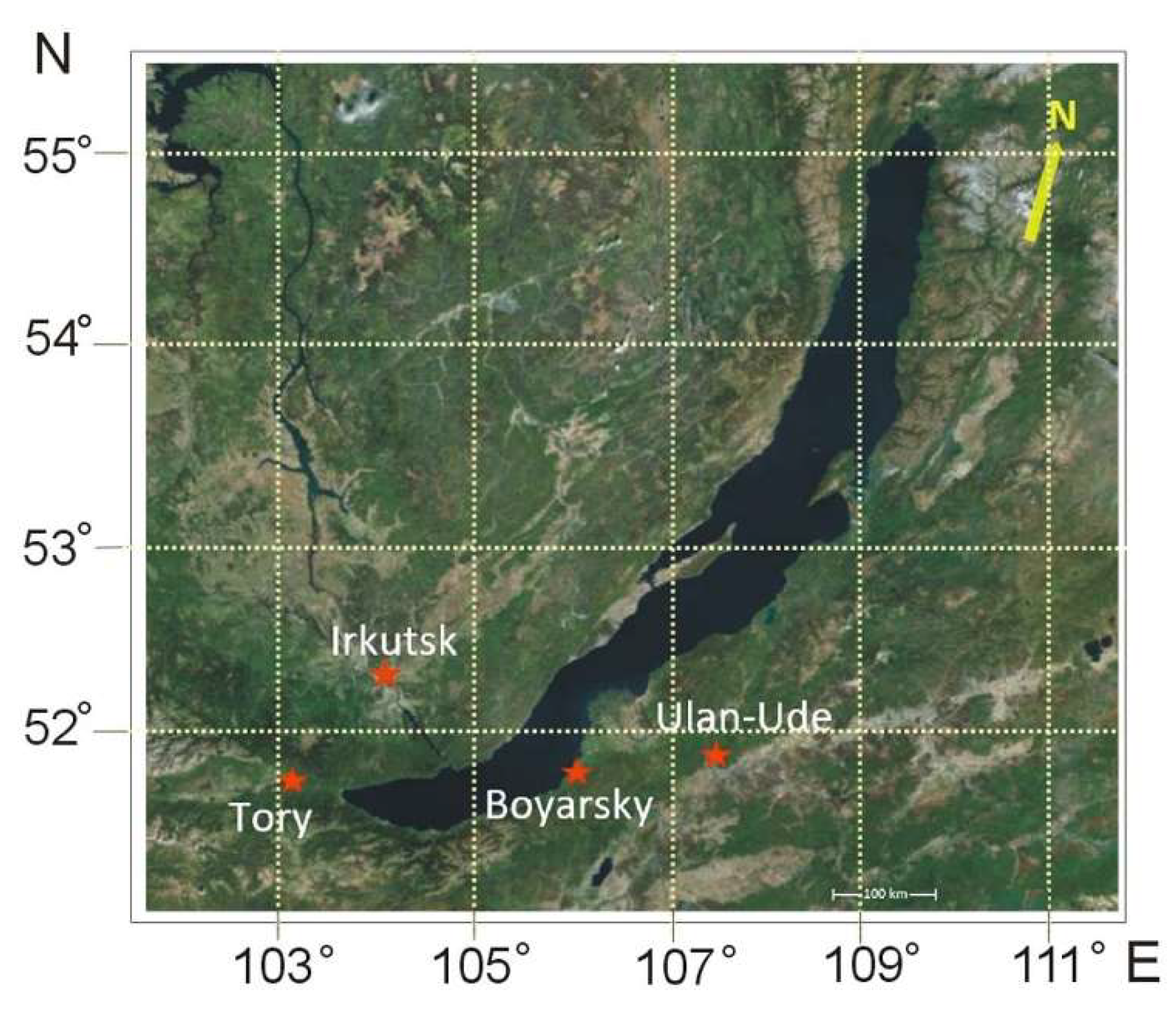
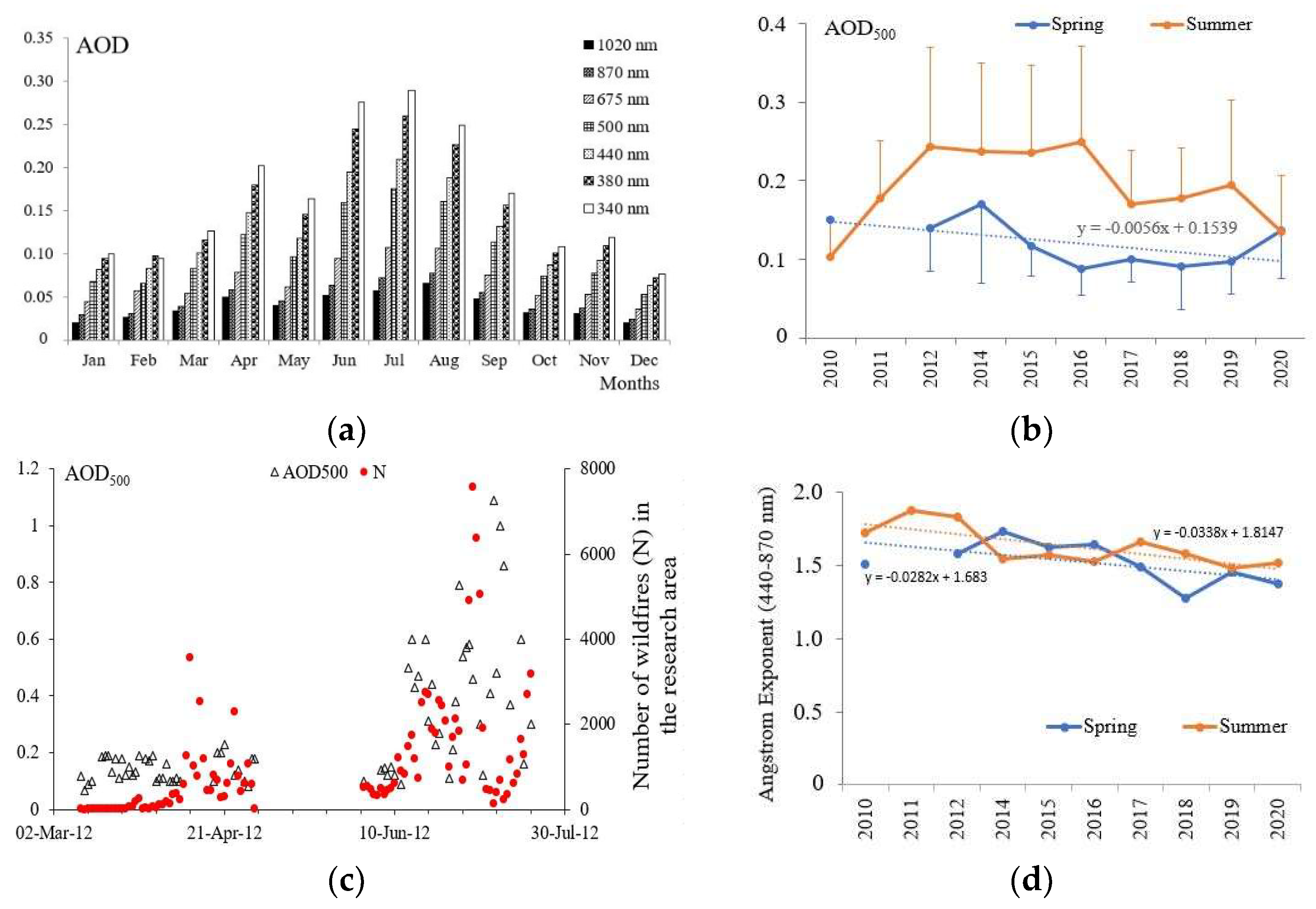
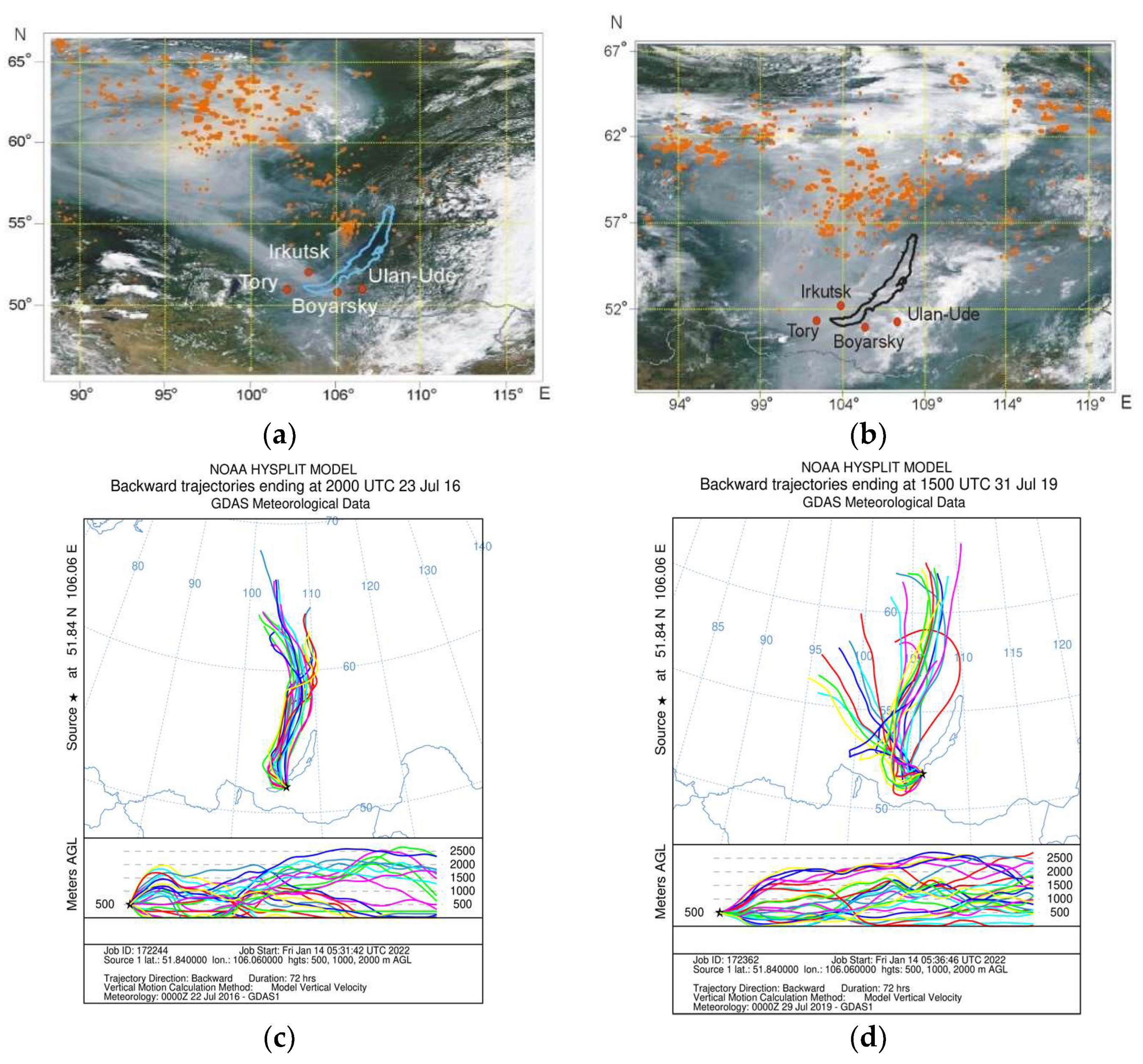

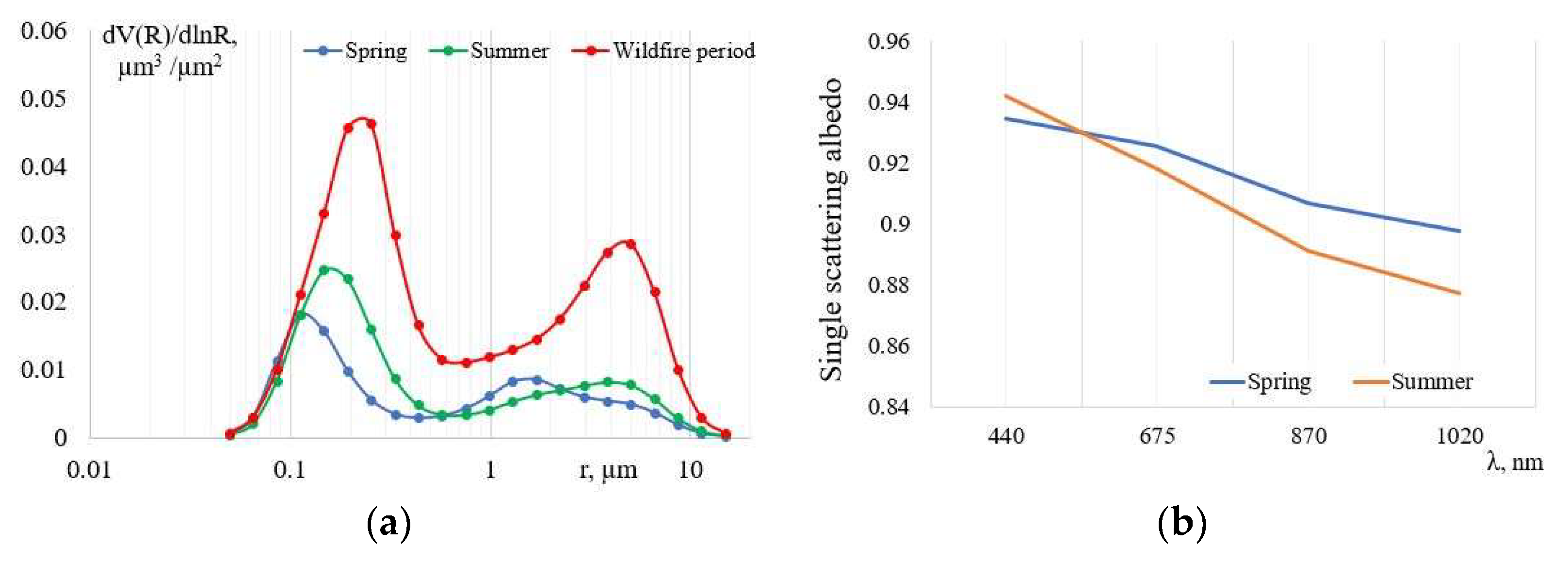
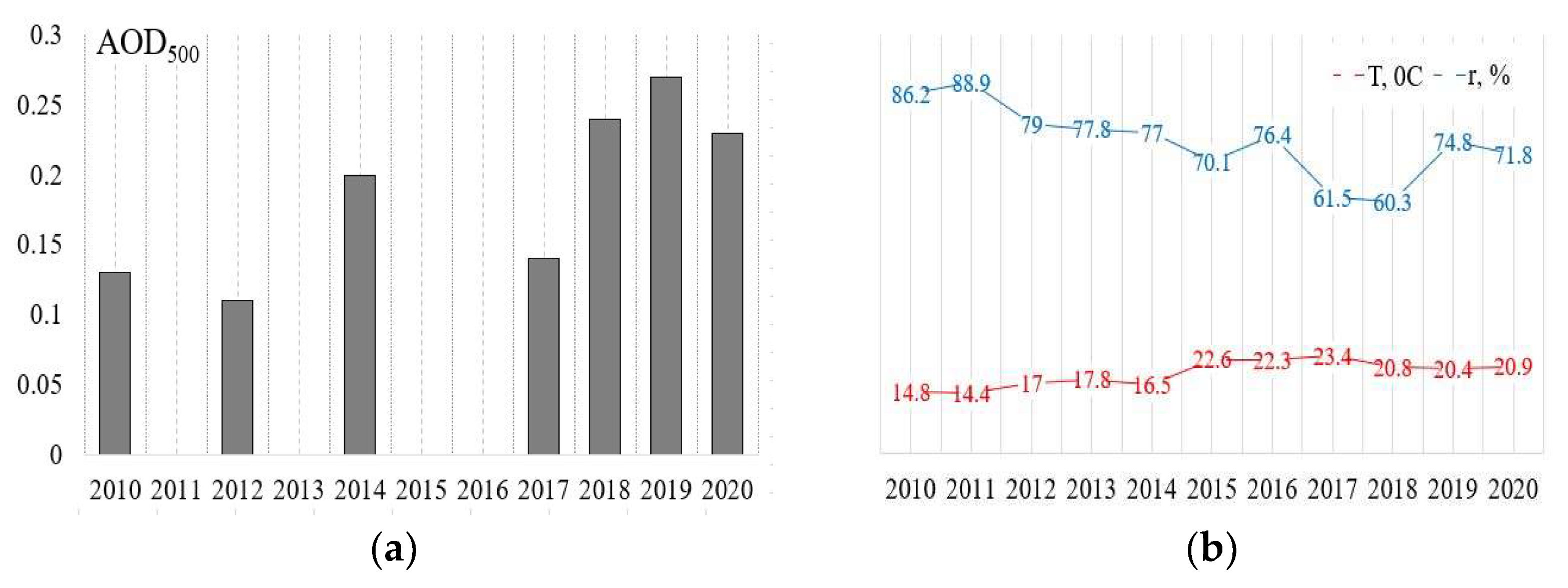
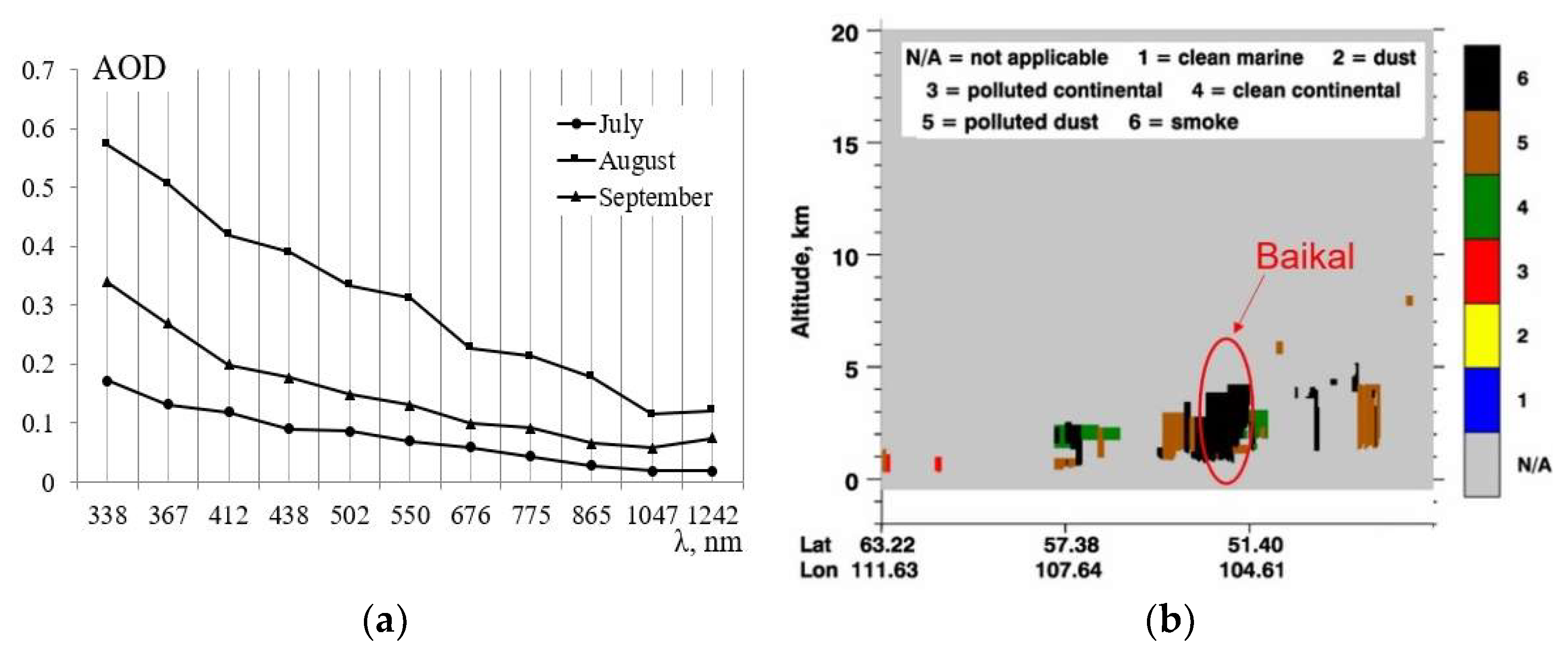
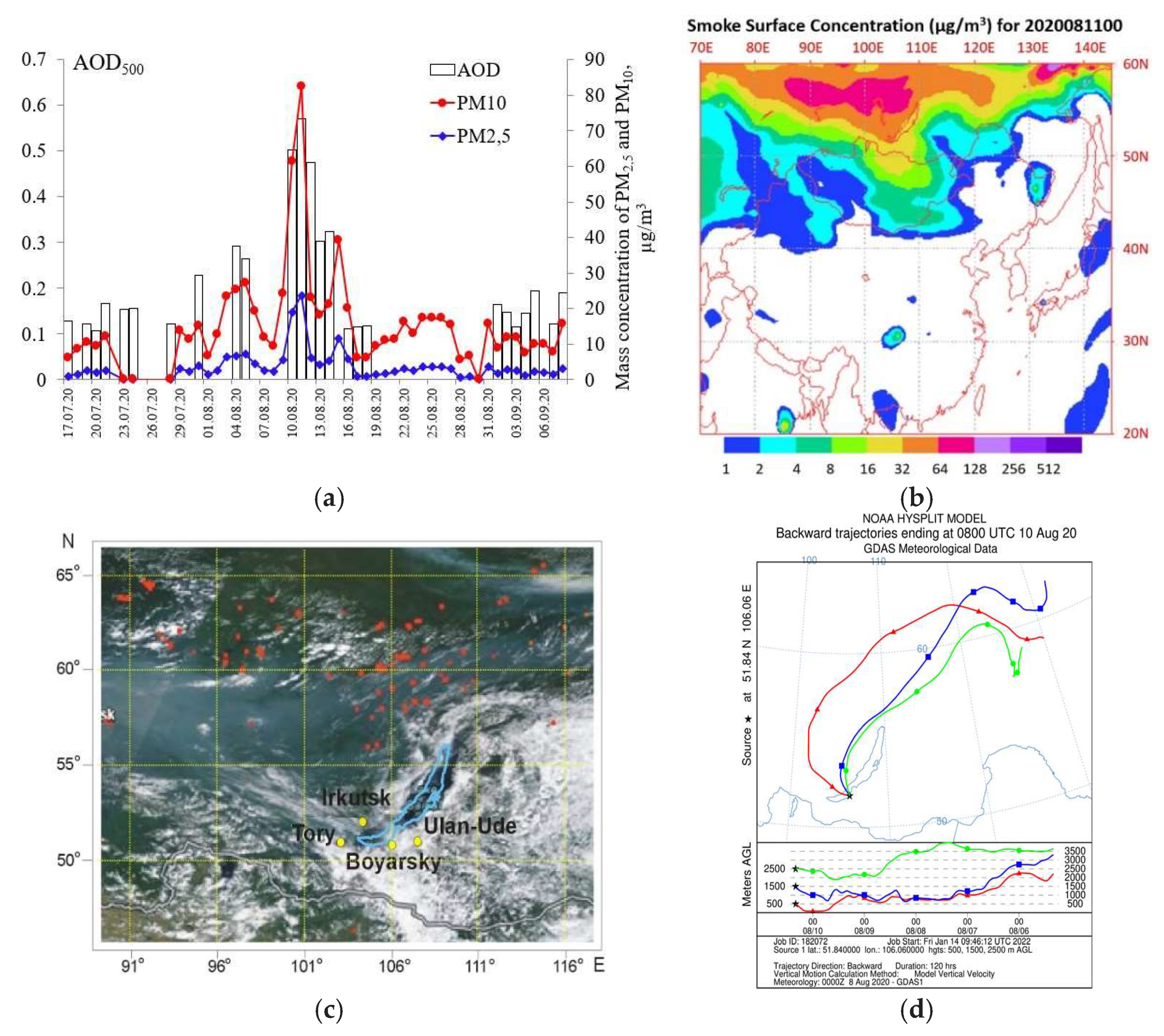
| Months | AOD500 | |||
|---|---|---|---|---|
| Mean | Standard Deviation | Min | Max | |
| January | 0.07 | 0.014 | 0.04 | 0.10 |
| February | 0.06 | 0.015 | 0.03 | 1.24 |
| March | 0.08 | 0.074 | 0.03 | 1.25 |
| April | 0.13 | 0.081 | 0.02 | 1.39 |
| May | 0.11 | 0.066 | 0.03 | 0.96 |
| June | 0.15 | 0.150 | 0.03 | 1.89 |
| July | 0.17 | 0.223 | 0.02 | 2.82 |
| August | 0.16 | 0.141 | 0.03 | 1.12 |
| September | 0.11 | 0.079 | 0.03 | 0.61 |
| October | 0.07 | 0.047 | 0.01 | 0.44 |
| November | 0.08 | 0.051 | 0.02 | 0.41 |
| December | 0.05 | 0.024 | 0.02 | 0.15 |
Publisher’s Note: MDPI stays neutral with regard to jurisdictional claims in published maps and institutional affiliations. |
© 2022 by the authors. Licensee MDPI, Basel, Switzerland. This article is an open access article distributed under the terms and conditions of the Creative Commons Attribution (CC BY) license (https://creativecommons.org/licenses/by/4.0/).
Share and Cite
Dementeva, A.; Zhamsueva, G.; Zayakhanov, A.; Tcydypov, V. Interannual and Seasonal Variation of Optical and Microphysical Properties of Aerosol in the Baikal Region. Atmosphere 2022, 13, 211. https://doi.org/10.3390/atmos13020211
Dementeva A, Zhamsueva G, Zayakhanov A, Tcydypov V. Interannual and Seasonal Variation of Optical and Microphysical Properties of Aerosol in the Baikal Region. Atmosphere. 2022; 13(2):211. https://doi.org/10.3390/atmos13020211
Chicago/Turabian StyleDementeva, Ayuna, Galina Zhamsueva, Alexander Zayakhanov, and Vadim Tcydypov. 2022. "Interannual and Seasonal Variation of Optical and Microphysical Properties of Aerosol in the Baikal Region" Atmosphere 13, no. 2: 211. https://doi.org/10.3390/atmos13020211
APA StyleDementeva, A., Zhamsueva, G., Zayakhanov, A., & Tcydypov, V. (2022). Interannual and Seasonal Variation of Optical and Microphysical Properties of Aerosol in the Baikal Region. Atmosphere, 13(2), 211. https://doi.org/10.3390/atmos13020211






